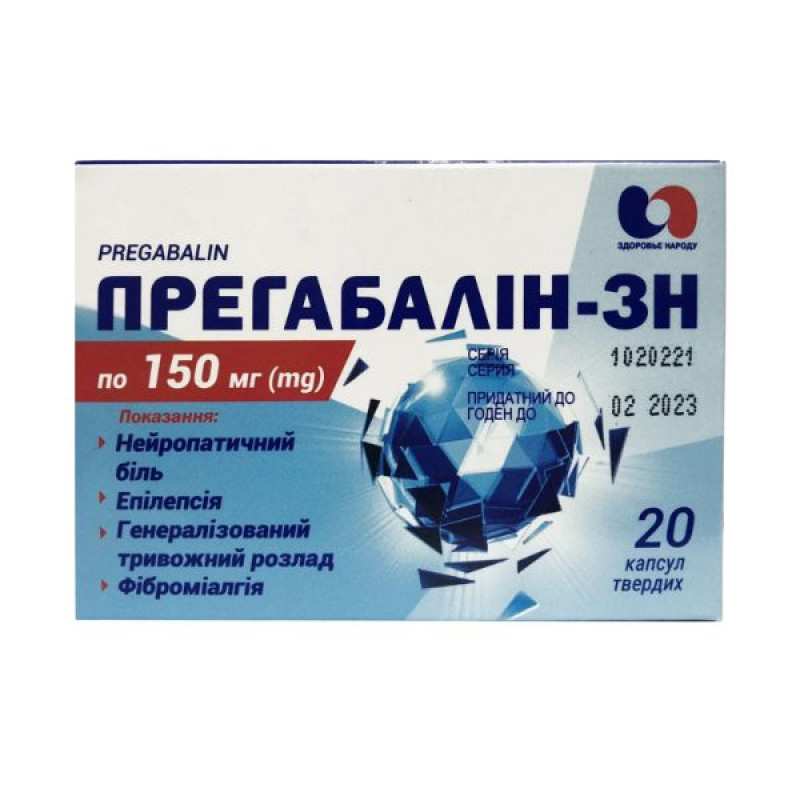Pregabalin-ZN hard capsules 150 mg blister No. 20

The drug "Pregabalin-ZN" is used for the following indications:
Neuropathic pain: treatment of neuropathic pain of peripheral or central origin in adults; Epilepsy: adjunctive therapy in partial seizures with or without secondary generalization in adults; Generalized anxiety disorder: treatment of generalized anxiety disorder in adults; Fibromyalgia.Composition
1 capsule contains pregabalin (active ingredient) 75 mg or 150 mg.
Excipients: lactose monohydrate; pregelatinized starch (granulated), magnesium stearate, titanium dioxide (E 171), gelatin, erythrosine (E 127), quinoline yellow (E 104) (for 75 mg capsules), indigo carmine (E 132) (for 150 mg capsules).
Contraindication
Hypersensitivity to the active substance or to any of the excipients of the medicinal product.
Method of administration and doses
Method of application.
Take regardless of food intake.
This medicine is for oral use only.
Doses.
The dosage range of the drug can vary within 150-600 mg/day. The daily dose is divided into 2-3 doses.
Neuropathic pain.
Pregabalin therapy can be initiated at a dose of 150 mg/day, divided into 2-3 doses. Depending on the individual response and tolerability of the drug by the patient, the dose can be increased to 300 mg/day after 3-7 days, and if necessary, to a maximum dose of 600 mg/day after another 7 days.
Epilepsy.
Pregabalin therapy can be initiated at a dose of 150 mg/day, divided into 2-3 doses. Depending on the individual response and tolerability of the drug by the patient, the dose can be increased to 300 mg/day after the first week of treatment. After another week, the dose can be increased to a maximum of 600 mg/day.
Generalized anxiety disorder.
The dose, divided into 2-3 doses, may vary within the range of 150-600 mg/day. The need for continued therapy should be reviewed periodically.
Pregabalin therapy can be initiated at a dose of 150 mg/day. Depending on the individual response and tolerability of the drug by the patient, the dose can be increased to 300 mg/day after the first week of treatment. After another week of treatment, the dose can be increased to 450 mg/day. After another week, the dose can be increased to a maximum of 600 mg/day.
Fibromyalgia.
The recommended dose of the drug for the treatment of fibromyalgia is 300 to 450 mg / day. Treatment should be initiated at a dose of 75 mg twice a day (150 mg / day). Depending on the effectiveness and tolerability, the dose can be increased to 150 mg twice a day (300 mg / day) within one week. For patients for whom the use of a dose of 300 mg / day is not sufficiently effective, the dose can be increased to 225 mg twice a day (450 mg / day). Although there is a study using a dose of 600 mg / day, there is no evidence that this dose will have an additional advantage; also, this dose was worse tolerated. Given the dose-dependent adverse reactions, the use of doses above 450 mg / day is not recommended. Since pregabalin is excreted primarily by the kidneys, the dose of the drug should be adjusted in patients with impaired renal function.
Pregabalin withdrawal.
In accordance with current clinical practice, it is recommended to discontinue pregabalin therapy gradually, over a period of at least one week, regardless of the indication.
Application features
Pregnant women
Women of childbearing potential/contraception for women and men.
Since the potential risk to humans is unknown, women of childbearing potential should use effective contraception.
Pregnancy.
There are no adequate data from the use of pregabalin in pregnant women.
Reproductive toxicity has been demonstrated in animal studies. The potential risk to humans is unknown.
The drug should be used during pregnancy only when the benefit to the mother clearly outweighs the possible risk to the fetus.
Breastfeeding period.
Small amounts of pregabalin have been detected in the milk of nursing women. Therefore, breastfeeding is not recommended while taking pregabalin.
Fertility.
There are no clinical data on the effect of pregabalin on female fertility.
In a clinical study to investigate the effect of pregabalin on sperm motility, healthy male volunteers were administered pregabalin at a dose of 600 mg/day. No effect on sperm motility was observed after 3 months of treatment.
Children
The safety and efficacy of the drug "Pregabalin-ZN" when used in children under the age of 18 have not been established. The safety and dosage of the drug when used are unknown.
Drivers
The drug may have minor or moderate influence on the ability to drive and use machines. It may cause dizziness and drowsiness and thus affect the ability to drive and use machines. Therefore, patients should be advised to refrain from driving, operating complex machinery or other potentially hazardous activities until it is known whether this drug affects their ability to perform such activities.
Overdose
There have also been reports of seizures.
Rare cases of coma have been reported.
Treatment of pregabalin overdose consists of general supportive measures and may include hemodialysis if necessary.
Adverse reactions
The most frequently reported adverse reactions were dizziness and somnolence. Adverse reactions were generally mild to moderate in severity. During the studies, the rate of discontinuation due to adverse reactions was 12% in patients receiving pregabalin and 5% in patients receiving placebo. The most frequently reported adverse reactions leading to discontinuation in the pregabalin group were dizziness and somnolence.
Storage conditions
Store in the original packaging at a temperature not exceeding 25 ° C. Keep out of the reach of children.
Shelf life - 2 years.
There are no reviews for this product.
There are no reviews for this product, be the first to leave your review.
No questions about this product, be the first and ask your question.




